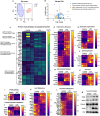Serum Extracellular Vesicles Reveal Metabolic Responses to Time-Restricted Feeding in High-Fat Diet-Induced Obesity in Male Mice
- PMID: 40552102
- PMCID: PMC12183342
- DOI: 10.1002/jex2.70062
Serum Extracellular Vesicles Reveal Metabolic Responses to Time-Restricted Feeding in High-Fat Diet-Induced Obesity in Male Mice
Abstract
Extracellular vesicle (EV) secretion and cargo composition are dysregulated in metabolic diseases. This study aimed to investigate how changes in serum EV concentration and protein composition reflect the metabolic effects of a high-fat diet (HFD) and time-restricted feeding (TRF), with a particular focus on adipocyte-derived EVs (Ad-EVs) in circulation. Mice were fed an HFD for 18 weeks prior to being placed either ad libitum or on a TRF for an additional 10 weeks. Mice on a normal chow ad libitum served as the control. The TRF group had food available for 10 h and fasted for 14 h per day. The serum EV size profile and amount displayed sex- and age-dependent changes in HFD-induced obesity, with age reducing EV amounts. HFD decreased small EV populations and increased larger EV populations, while TRF reversed these changes. Quantitative proteomic analysis showed that the abundance and composition of EV proteins changed in response to both acute stimulation with lipopolysaccharides (LPS) and HFD. Gene ontology analysis identified specific sets of EV proteins and their involved biological processes, reflecting the effect of LPS and HFD, as well as the reversal effect of TRF on metabolic and inflammatory pathways. EV proteins altered by HFD and those reversed by TRF had low protein overlap but significant functional overlap in biological processes. TRF activated the PPAR signalling pathway and the AKT-mTOR signalling pathway. The most significant impacts of HFD and TRF were observed on lipoprotein and carbohydrate metabolism, the complement system, and neutrophil degranulation. Additionally, we showed that serum Ad-EVs respond dynamically to HFD and TRF. Our findings suggest that EVs play a role in diet-induced metabolic and inflammatory responses, with changes in circulating EVs, particularly Ad-EVs, reflecting metabolic adaptations to dietary exposures and interventions.
Keywords: extracellular vesicles; inflammation; obesity; proteomics; time‐restricted feeding.
© 2025 The Author(s). Journal of Extracellular Biology published by Wiley Periodicals, LLC on behalf of the International Society for Extracellular Vesicles.
Conflict of interest statement
The authors declare no conflict of interest.
Figures





Update of
-
Serum Extracellular Vesicles Reveal Metabolic Responses to Time-Restricted Feeding in High Fat Diet-Induced Obesity in Male Mice.Res Sq [Preprint]. 2024 Sep 24:rs.3.rs-4745029. doi: 10.21203/rs.3.rs-4745029/v1. Res Sq. 2024. Update in: J Extracell Biol. 2025 Jun 23;4(6):e70062. doi: 10.1002/jex2.70062. PMID: 39399666 Free PMC article. Updated. Preprint.
Similar articles
-
Serum Extracellular Vesicles Reveal Metabolic Responses to Time-Restricted Feeding in High Fat Diet-Induced Obesity in Male Mice.Res Sq [Preprint]. 2024 Sep 24:rs.3.rs-4745029. doi: 10.21203/rs.3.rs-4745029/v1. Res Sq. 2024. Update in: J Extracell Biol. 2025 Jun 23;4(6):e70062. doi: 10.1002/jex2.70062. PMID: 39399666 Free PMC article. Updated. Preprint.
-
The separation and identification of circulating small extracellular vesicles from endurance-trained, strength-trained and recreationally active men.J Physiol. 2023 Nov;601(22):5075-5091. doi: 10.1113/JP285170. Epub 2023 Sep 19. J Physiol. 2023. PMID: 37725436
-
Hypothalamic gliosis as a potential mediator of improved glucose tolerance induced by time-restricted feeding in obese mice.Am J Physiol Cell Physiol. 2025 Sep 1;329(3):C834-C847. doi: 10.1152/ajpcell.00357.2025. Epub 2025 Jul 31. Am J Physiol Cell Physiol. 2025. PMID: 40741982 Free PMC article.
-
Signs and symptoms to determine if a patient presenting in primary care or hospital outpatient settings has COVID-19.Cochrane Database Syst Rev. 2022 May 20;5(5):CD013665. doi: 10.1002/14651858.CD013665.pub3. Cochrane Database Syst Rev. 2022. PMID: 35593186 Free PMC article.
-
Systemic pharmacological treatments for chronic plaque psoriasis: a network meta-analysis.Cochrane Database Syst Rev. 2021 Apr 19;4(4):CD011535. doi: 10.1002/14651858.CD011535.pub4. Cochrane Database Syst Rev. 2021. Update in: Cochrane Database Syst Rev. 2022 May 23;5:CD011535. doi: 10.1002/14651858.CD011535.pub5. PMID: 33871055 Free PMC article. Updated.
References
-
- Blandin, A. , Amosse J., Froger J., et al. 2023. “Extracellular Vesicles Are Carriers of Adiponectin With Insulin‐Sensitizing and Anti‐Inflammatory Properties.” Cell Reports 42: 112866. - PubMed
Grants and funding
LinkOut - more resources
Full Text Sources
Miscellaneous
